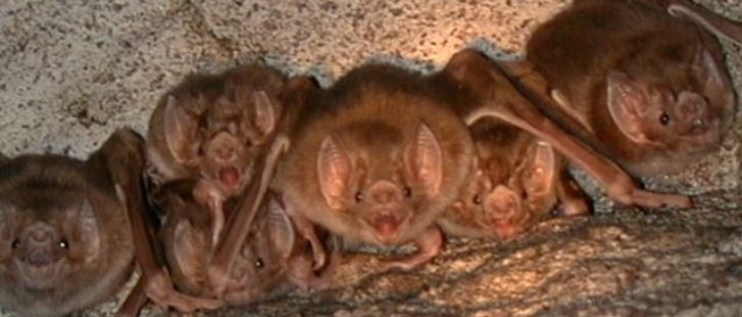
Reproduction
Male and female vampire bats tend to roost separately within the same habitat. Female bats will huddle together in one corner while males will huddle in the opposing corner. Although separate, a few dominant males (2 or more) will be included in the female roost. The role of the males within the group of females is to protect the females, the youth, and the sub adults. Although known to roost separately, when temperatures get below 11°C the vampire bats will all huddle together in order to maintain internal body temperatures. Due to closeness through colder months (winter) it is the most common time for female vampire bats to become pregnant (Delpietro & Russo 2001).
Vampire bats are mammals so their reproduction is similar to that of humans. Desmodus rotundus carry their young within their bodies. The vampire bat carries its fetus for an extended period of time, varying from three to seven and half months (Delpietro & Russo 2001). Females usually give birth about once a year with most births happening in the spring and summer months. When a female vampire bat goes into labor she will fly to the top of her dwelling and hang upside down, upside down to a bat is what people would consider right side up. She hangs this way so that she can create a pouch with her wings and curled up tail (vampire-bats.net). Female bats construct this pouch to catch the pup (baby bat) when he or she is delivered. Once the pup is delivered he or she remains very close to its mother for quite some time.
The vampire bat has one of the longest gestation periods of all bats. Once a vampire bat has given birth the newborn is often attached to a nipple for feeding for many days if not weeks. Many female vampire bats have offspring at similar times and are often nursing all in the same period of time. Because females are all nursing at parallel times they will often nurse the young of other females. Something unique to the reproduction of vampire bats is the idea of adoption. If a female bat dies and the young is left alone, another female bat will adopt the young bat as its own and nurse it into to adulthood (vampire-bats.net). Once a young bat is weaned off the nipple, the mother will begin to feed to small bat via regurgitation. Not only does the vampire bat have a long gestation period but it is also a bat species that has a long period of growth before being considered an adult. This prolonged period of growth is thought to be because of the great deal of hunting techniques that need to be learned before venturing out alone. Birth and growth periods in vampire bats have often been found to correlate to those of small domestic mammals such as cows. Is this correlation a coincidence? Probably not, to find out why, read more about the common vampire bat's nutrition and interactions with other species.
